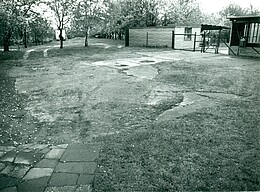Hannover-Ahlem (A 12)
At the end of November 1944, an advance commando consisting of around 100 concentration camp prisoners from the Hannover-Stöcken satellite camp reached Ahlem, where they were forced to set up huts on property belonging to Continental Gummi-Werke AG and build washrooms and housing for the SS. On 30 November 1944, most of the prisoners from the Stöcken satellite camp were transferred to Ahlem, bringing the total number of prisoners to about 840 men.
The prisoners, most of whom were Jewish, were used to construct an underground tunnel to house the operations of the Continental Gummi-Werke rubber factory and the Maschinenfabrik Niedersachsen Hannover. The project bore the cover name "A 12". This difficult work and the terrible conditions underground led to a high death rate. In January 1945, a transport consisting mostly of Soviet prisoners from Neuengamme main camp reached the Ahlem satellite camp. These prisoners were meant to replace prisoners who had died or become “unable to work”.
Preparations for the evacuation of the camp began in Hannover-Ahlem as early as April 5, 1945. A day later, the prisoners who were still able to walk left the concentration camp and set off in the direction of Bergen-Belsen. It is not known how many prisoners were murdered by SS men along the way. Around 200 sick prisoners were liberated by American soldiers in Ahlem on 10 April 1945.
SS-Hauptscharführer Otto “Tull” Harder, a well-known former Hamburg football player, was commander of the Ahlem satellite camp. Many survivors also remember the feared SS-Rottenführer Wilhelm Damann.
Period
30 November 1944 to 10 April 1945
Number of Prisoners
840 Male Prisoners
Kind of Work
Construction of an underground tunnel
Labor on Behalf of
Continental Gummi-Werke AG, Maschinenfabrik Niedersachsen
Location
Directions
Gedenkstätte Ahlem
Heisterbergallee 8
30453 Hannover
Germany
Tel.: +49 (0) 511 – 6 16 22 25 6
Monument: A narrow path named "Am Mahnmal" branches off from Heisterbergallee (next to the English Cemetery), 30455 Hannover, Germany.
Directions by public transportation:
Gedenkstätte Ahlem: City railway (Stadtbahn) line 10 in the direction of Ahlem via Aegidientorplatz and the Hauptbahnhof to the “Ehrhartstraße” stop.
Monument: City railway (Stadtbahn) line 10 in the direction of Ahlem via Aegidientorplatz and the Hauptbahnhof to the end of the line, then about 5 minutes on foot.
The monument is accessible at all times.
Memorial
In 1987, the working group known as Citizens Design a Memorial (Bürger gestalten ein Mahnmal) campaigned for a worthy memorial on the site of the former Ahlem satellite camp. This grassroots project was supported by the Hannover Cultural Office in cooperation with other public institutions. A monument was finally erected in the immediate vicinity of the former camp and dedicated on 4 February 1994. It symbolises the entrance to the tunnel and features numerous asphalt plaques on its two side walls. These plaques were individually designed by members of the working group and other citizens of Hannover. This monument, which was made largely by the working group itself, was supplemented in 2001 with two copper steles bearing the names of 299 victims of the Ahlem camp.
An exhibition on the history of the satellite camp can be found at the Ahlem Memorial which opened in 1987. An exhibit in a building belonging to the Justus-von-Liebig School (which was the Israelite School of Horticulture Ahlem until 1942) tells the story of the horticultural school and its use as a central assembly point for the deportation of Jewish citizens from the Hannover/Hildesheim region and as a Gestapo prison.
Contact
Gedenkstätte Ahlem
Heisterbergallee 8
30453 Hannover
Tel.: +49 (0) 511 – 6 16 22 25 6
Website: www.gedenkstaette-ahlem.de
ZeitZentrum Zivilcourage [Z]
Theodor-Lessing-Platz 1a
30159 Hannover
Email: erinnerungskultur@hannover-stadt.de
Website: www.hannover.de/das-z


